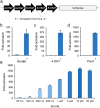Regulation of endogenous human gene expression by ligand-inducible TALE transcription factors
- PMID: 24251925
- PMCID: PMC4097969
- DOI: 10.1021/sb400114p
Regulation of endogenous human gene expression by ligand-inducible TALE transcription factors
Abstract
The construction of increasingly sophisticated synthetic biological circuits is dependent on the development of extensible tools capable of providing specific control of gene expression in eukaryotic cells. Here, we describe a new class of synthetic transcription factors that activate gene expression in response to extracellular chemical stimuli. These inducible activators consist of customizable transcription activator-like effector (TALE) proteins combined with steroid hormone receptor ligand-binding domains. We demonstrate that these ligand-responsive TALE transcription factors allow for tunable and conditional control of gene activation and can be used to regulate the expression of endogenous genes in human cells. Since TALEs can be designed to recognize any contiguous DNA sequence, the conditional gene regulatory system described herein will enable the design of advanced synthetic gene networks.
Keywords: TALE; gene regulation; inducible gene expression; steroid hormone receptor; transcription factor.
Figures





Similar articles
-
Design, Assembly, and Characterization of TALE-Based Transcriptional Activators and Repressors.Methods Mol Biol. 2016;1338:71-88. doi: 10.1007/978-1-4939-2932-0_7. Methods Mol Biol. 2016. PMID: 26443215 Free PMC article.
-
TALE activators regulate gene expression in a position- and strand-dependent manner in mammalian cells.Biochem Biophys Res Commun. 2014 Jan 24;443(4):1189-94. doi: 10.1016/j.bbrc.2013.12.111. Epub 2013 Dec 28. Biochem Biophys Res Commun. 2014. PMID: 24380858
-
Synthetic mammalian trigger-controlled bipartite transcription factors.Nucleic Acids Res. 2013 Jul;41(13):e134. doi: 10.1093/nar/gkt405. Epub 2013 May 17. Nucleic Acids Res. 2013. PMID: 23685433 Free PMC article.
-
Transcription activator-like effectors: a toolkit for synthetic biology.ACS Synth Biol. 2014 Oct 17;3(10):708-16. doi: 10.1021/sb400137b. Epub 2014 Feb 13. ACS Synth Biol. 2014. PMID: 24933470 Free PMC article. Review.
-
TALE: a tale of genome editing.Prog Biophys Mol Biol. 2014 Jan;114(1):25-32. doi: 10.1016/j.pbiomolbio.2013.11.006. Epub 2013 Nov 27. Prog Biophys Mol Biol. 2014. PMID: 24291598 Review.
Cited by
-
Synthetic Gene Circuits for Regulation of Next-Generation Cell-Based Therapeutics.Adv Sci (Weinh). 2024 Feb;11(8):e2309088. doi: 10.1002/advs.202309088. Epub 2023 Dec 21. Adv Sci (Weinh). 2024. PMID: 38126677 Free PMC article. Review.
-
Engineering Gene Circuits for Mammalian Cell-Based Applications.Cold Spring Harb Perspect Biol. 2016 Jul 1;8(7):a023895. doi: 10.1101/cshperspect.a023895. Cold Spring Harb Perspect Biol. 2016. PMID: 27194045 Free PMC article. Review.
-
Application of TALEs, CRISPR/Cas and sRNAs as trans-acting regulators in prokaryotes.Curr Opin Biotechnol. 2014 Oct;29:46-54. doi: 10.1016/j.copbio.2014.02.010. Epub 2014 Mar 12. Curr Opin Biotechnol. 2014. PMID: 24632195 Free PMC article. Review.
-
Modes of TAL effector-mediated repression.Nucleic Acids Res. 2014 Dec 1;42(21):13061-73. doi: 10.1093/nar/gku1124. Epub 2014 Nov 11. Nucleic Acids Res. 2014. PMID: 25389273 Free PMC article.
-
TALEN and CRISPR/Cas Genome Editing Systems: Tools of Discovery.Acta Naturae. 2014 Jul;6(3):19-40. Acta Naturae. 2014. PMID: 25349712 Free PMC article.
References
-
- Slusarczyk A. L.; Lin A.; Weiss R. (2012) Foundations for the design and implementation of synthetic genetic circuits. Nat. Rev. Genet. 13, 406–420. - PubMed
-
- Folcher M.; Fussenegger M. (2012) Synthetic biology advancing clinical applications. Curr. Opin. Chem. Biol. 16, 345–354. - PubMed
-
- Auslander S.; Fussenegger M. (2013) From gene switches to mammalian designer cells: present and future prospects. Trends Biotechnol. 31, 155–168. - PubMed
-
- Gardner T. S.; Cantor C. R.; Collins J. J. (2000) Construction of a genetic toggle switch in Escherichia coli. Nature 403, 339–342. - PubMed
Publication types
MeSH terms
Substances
Grants and funding
LinkOut - more resources
Full Text Sources
Other Literature Sources

